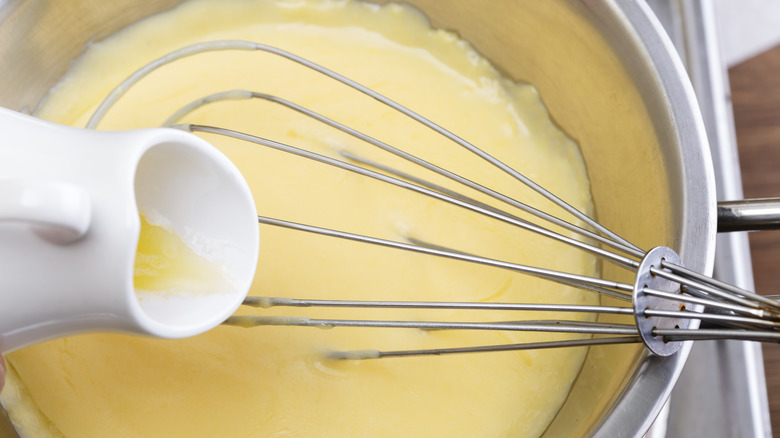Why You Should Never Let Hollandaise Sauce Get Cold
While Hollandaise sauce or Dutch sauce is most famously featured in eggs Benedict, it also pairs perfectly with grilled steak or salmon and freshly blanched asparagus or broccoli . Consisting of egg yolks, melted butter, lemon juice, and black pepper, this staple sauce is not only rich in flavor but requires mastering an emulsion technique. In fact, it's rather hard to do by yourself, and having another set of hands is helpful — one set for whisking and holding the bowl and the other for slowly drizzling in the warm melted butter.
During this process, the temperature of the butter slowly starts to temper the eggs, which prevents them from scrambling and, instead, creates a glossy sauce that is warm and loose enough for drizzling yet thick enough for smothering. Although, because this emulsion is determined by temperature, it will break if it gets too hot or too cold. Therefore, hollandaise sauce should be served as soon as it's made.
Letting the sauce get cold will turn the texture from silky smooth to somewhat lumpy, and heating it up will cause the eggs to scramble. This is due to the emulsion breaking because the fat has separated from the water.
It breaks the emulsion
The fat used in hollandaise sauce is butter, which of course, begins to solidify at room temperature or colder. This is what causes those unsightly lumps when the sauce cools, and unfortunately, while reheating hollandaise sauce will melt the butter, it will also cause the eggs to coagulate. Both of these instances are a result of a broken emulsion. To stay on the safer and more delicious side of things, it's best not to waste any time and serve this type of sauce right away.
If you're hosting a brunch and eggs Benedict is on the menu, it's not realistic to have to continuously whisk up batches of hollandaise sauce as the party goes on. While a cold hollandaise sauce is the last thing you want — and so is an overheated scrambled egg sauce — there is one trick to keeping it at the perfect temperature so that it stays silky smooth and ladle-able – a double-boiler! Simply have enough water in a pot to reach about an inch up the sides, place a glass bowl sitting on top that holds your hollandaise sauce, and be sure the burner is on low heat. With a probe thermometer, monitor the temperature so that it doesn't reach above 100 degrees Fahrenheit. Any hotter, and the sauce could split. As long as the burner is kept at an extremely low temperature, it's safe to keep your sauce in a serveable state like this for up to 30 minutes.

